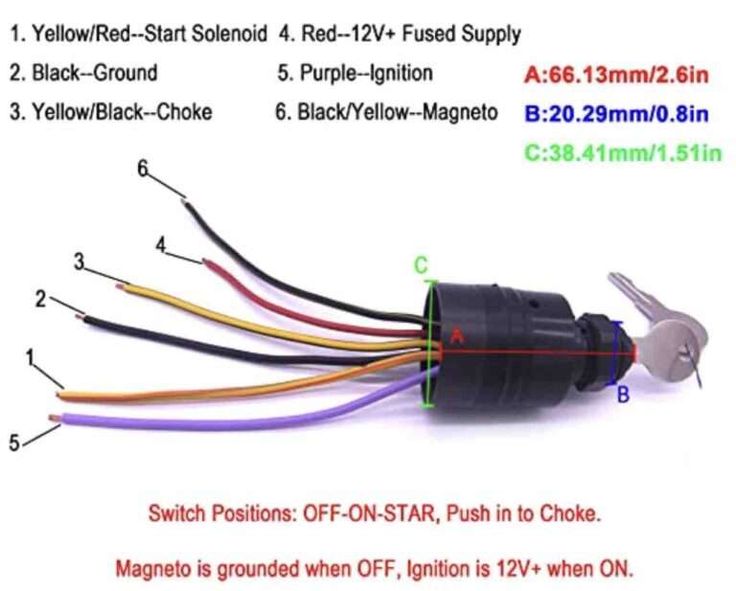When it comes to the world of automobiles, few systems are as crucial yet often overlooked as the ignition system. The ignition switch, in particular, acts as the lynchpin for starting your vehicle. It’s easy to take for granted, but understanding the wiring color codes associated with ignition switches can significantly enhance your grasp of automotive mechanics. This knowledge not only empowers you during troubleshooting but also sparks a curiosity to delve deeper into the engineering marvels that keep our vehicles running smoothly.
**Understanding the Basics of the Ignition Switch**
At the heart of your vehicle’s ignition system lies the ignition switch. This component is responsible for initiating the flow of electricity needed to start the engine. When you turn the key in the ignition, you’re not just flipping a switch; you’re initiating a complex electrical dance between multiple components. The ignition switch sends power to the ignition coil, fuel system, and other electrical systems that are pivotal for your vehicle’s performance.
However, the question arises: How do you determine which wire goes where? This is where understanding the wiring color codes comes in. Each wire serves a specific function, and knowing which color corresponds to what role can simplify repairs and modifications immensely.
**Common Wiring Color Codes**
The ignition switch wiring color codes may vary depending on the make, model, and year of your vehicle. Nevertheless, there are several colors that commonly recur across different vehicle brands. Familiarizing yourself with these can be akin to learning a new language—a language spoken by automobiles everywhere.
- Red Wires: Typically represent constant power. These wires are powered even when the vehicle is off. They serve as the main feed to components that require a steady supply of electricity.
- Blue Wires: Generally signify the starter motor engagement circuit. Briefly connecting these wires connects the battery to the starter, allowing the engine to turn over.
- Yellow Wires: Often indicate ignition power. When the ignition switch is turned to the “ON” position, these wires deliver power to the ignition system.
- Green Wires: Typically signify accessory power. These wires power devices such as radios and air conditioning units only when the ignition is engaged.
- Brown Wires: Sometimes indicate ground connections. Essential for completing electrical circuits, these wires ground various components to ensure safe operation.
Keep in mind, though, that it is paramount to reference your vehicle’s wiring diagram to ensure accuracy, as color codes can differ based on numerous factors.
**The Importance of a Wiring Diagram**
Every vehicle often comes equipped with a wiring diagram, which is a schematic representation illustrating how the electrical components are interlinked. A good wiring diagram acts as a roadmap, guiding you through the maze of wires that thread through your vehicle. Utilizing this diagram to understand the ignition wiring can mean the difference between a successful repair and a visit to the mechanic.
Imagine attempting to navigate a foreign city without a map. The chaos could lead to frustration or even disaster. This predicament mirrors the real-world consequences of improper wiring. A small error, such as swapping two wires or neglecting to reconnect a wire, can lead to significant operational issues. Thus, ensuring you have a reliable wiring diagram is akin to having a trusted GPS—an essential tool for any DIY automotive enthusiast.
**Hands-On Approach: Testing and Troubleshooting**
Once you’re familiar with the wiring color codes and you have your wiring diagram handy, it may be enticing to take a hands-on approach. However, caution must be exercised. When diagnosing an ignition switch, it’s vital to check the continuity and voltage of each wire. This can reveal hidden problems, such as frayed wires or poor connections, which could impede your vehicle’s performance.
For individuals new to automotive wiring, utilizing a multimeter can be invaluable. This tool allows you to measure voltage and resistance, revealing whether each wire is functioning correctly. Engaging in such troubleshooting is not just about fixing a problem; it’s about embracing the intricacies of your vehicle’s electrical system.
**The Shift in Perspective: Understanding Over Avoiding**
Many vehicle owners perceive their car as just a means of transportation, a vehicle that gets them from point A to B. However, by investing time in understanding the ignition switch wiring, you cultivate a deeper appreciation for the engineering that works tirelessly beneath the hood. Each component is a testament to modern ingenuity, waiting to be celebrated. Understanding wiring color codes is just the tip of the iceberg; this knowledge can lead to a curious exploration of further automotive wonders, such as the complexities of computerized engine management or innovative fuel delivery systems.
In conclusion, grappling with the ignition switch wiring color codes may appear daunting initially. Yet, it promises to unlock a broader understanding of automotive systems and piques a curiosity that may lead you on a continuous journey of knowledge. So, the next time you turn your key in the ignition, reflect on the intricate dance of wires that bring your engine to life and revel in the remarkable world of automotive engineering.
